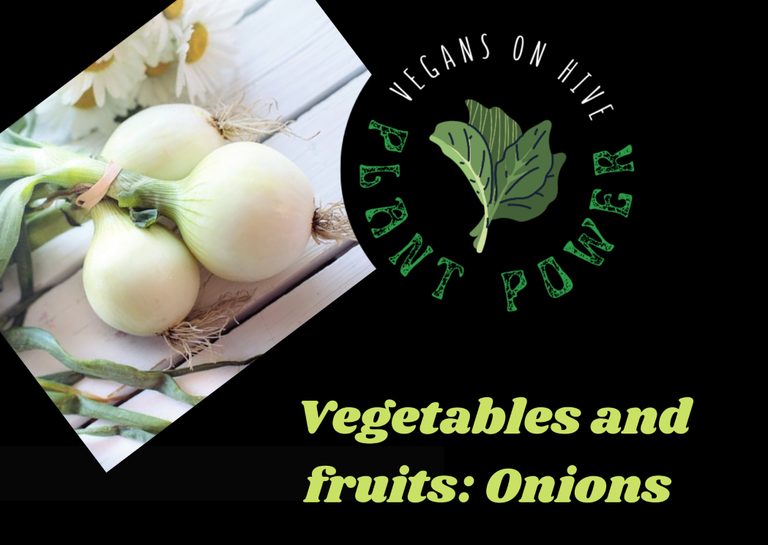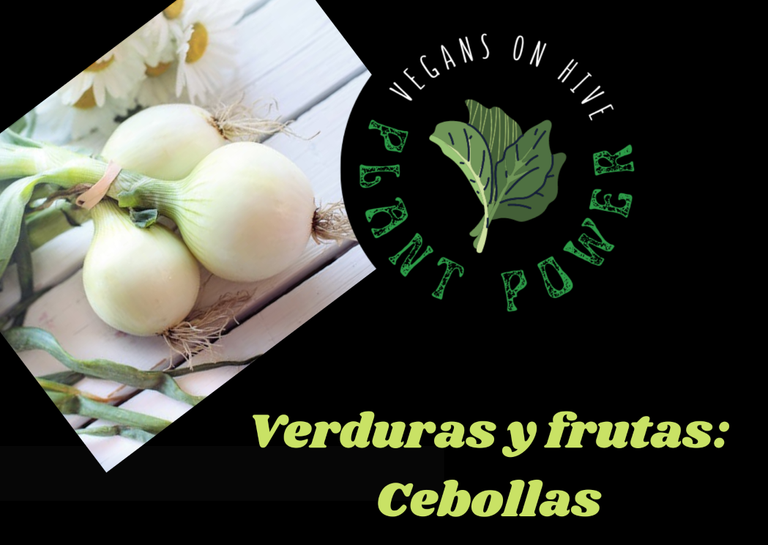
ENGLISH
Hello plant-based foodies, wherever you are in the world and/or galaxy!
Here @sirenahippie

In general, ripe onions can be stored for a long time (up to 8 months) outside the refrigerator, in a dry, well-ventilated place, for example, in well-ventilated baskets or hanging in strings. They can also be stored in the refrigerator, wrapped in absorbent paper, free from moisture. An important characteristic of onions is that when cut, they expel a substance that makes them "cry," that is, irritates the eyes. This substance is called thiopropanal oxide. Interestingly, if onions are harvested before they are ripe, they tend to have a plastic-like flavor, which is very unpleasant to the palate.


WAYS TO COOK ONIONS
- Raw: In salads, either diced or thinly sliced. In sandwiches, in rings or thinly sliced.
- Sautéed: For which they can be cut into cubes, rings, half-moons or slices, accompanied by other vegetables.
- Stew: As part of creams, soups, sauces, and vegetable stews.
- Baked: They can be baked filled with rice, textured soy or other vegetables.
- Fried: Breaded fried onion rings are delicious and very crispy. You can also finely chop the onions and fry them until very crispy. Drain, dry, and store them in sterile containers. They're ideal as a side dish or to add flavor to any other dish.
- Confitadas: Slowly cooked in oil, the onions transfer all their flavor to the oil, and can be stored for a long time.
- Caramelized: They are fried in a little oil, at a low temperature until they caramelize due to the sugars they contain.
- Dehydrated: They can be dehydrated in the sun, in an oven, or in a dehydrator, and once dried, stored in sterile jars. Another option is to pulverize them once they're fully dehydrated, turning them into onion powder.

As you can see, onions are a tasty food that can be prepared in many ways, and they're also healthy. It's an ingredient that can add much more flavor to your vegan dishes, so we invite you to experiment with new techniques and recipes using them.


ESPAÑOL

¡Hola amantes de los alimentos basados en plantas, donde quiera que estén en el mundo y/o la galaxia!
Aquí @sirenahippie

En general, las cebollas que estén maduras, pueden conservarse por largo tiempo (hasta 8 meses), fuera del frigorífico, en un sitio seco y aireado, por ejemplo, en cestas que brinden suficiente ventilación, o colgando en ristras. También pueden conservarse en la nevera, envueltas en papel absorbo, libres de humedad. Una característica importante de las cebollas, es que al ser cortadas expelen una sustancia que hace “llorar”, o sea, genera irritación ocular. Esta sustancia se denomina óxido de tiopropanal. Un dato curioso, es que si las cebollas son cosechadas antes de estar maduras, tienden a tener un sabor similar al plástico, muy desagradable al paladar.


FORMAS DE COCINAR LAS CEBOLLAS
- Crudas: En ensaladas ya sea cortada en dados o en rodajas finas. En sándwichs, en aros o rodajas finas.
- Salteadas: Para lo cual se pueden cortar en cubos, aros, media lunas o rodajas, acompañadas de otros vegetales.
- Guisadas: Como parte de cremas, sopas, salsas y guisos de vegetales.
- Horneada: Pueden hornearse rellenas con arroz, soya texturizada u otros vegetales.
- Fritas: Los aros de cebollas fritos rebozados, son deliciosos y muy crujientes. También pueden picarse finamente a las cebollas, y freírse hasta que queden muy crujientes, escurrirlas, secarlas y guardarlas en envases estériles. Son ideales como guarnición o para añadir sabor a cualquier otro plato.
- Confitadas: Cocidas lentamente en aceite, las cebollas transfieren todo su sabor al aceite, y se pueden conservar por largo tiempo.
- Caramelizadas: Se fríen en poco aceite, a baja temperature hasta que se caramelizan por los azúcares que contienen.
- Deshidratadas: Pueden deshidratarse al sol, en horno o en un deshidratador, y una vez secas, conservarse en frascos estériles. Otra opción es luego de estar totalmente deshidratadas, pulverizarlas, convirtiéndolas en cebolla en polvo.

Como pueden ver, la cebolla es un alimento sabroso, que tiene muchas formas de prepararse, y además es saludable. Es un ingrediente que puede dar mucho más sabor a tus preparaciones veganas, así que les invitamos a experimentar nuevas técnicas y recetas con ella

BIBLIOGRAPHY / BIBLIOGRAFÍA

RELATED POSTS / POSTS RELACIONADOS
Vegetables and fruits: Potatoes / Verduras y frutas: Patatas (ENG / SPN)
Vegetables and fruits: Pumpkin / Verduras y frutas: Calabaza (ENG / SPN)
Ideas for starting a vegan diet / Ideas para iniciar una alimentación vegana (ENG / SPN)
Three wonderful vegan channels (on YouTube)
How to properly preserve vegetables / Cómo conservar las verduras apropiadamente(ENG / SPN)
Vegan substitutes / Sustitutos veganos (ENG / SPN)
Vegetarian eating styles / Estilos de alimentación vegetariana (ENG / SPN)
Why should we eat fruits daily? / Porqué debemos comer frutas a diario? (ENG / SPN)


Delegations welcome!